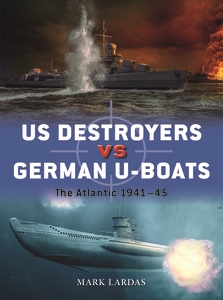
The engagements fought between the US Navy and the Kriegsmarine on the routes taken by the Britain-bound SC and HX and the America-bound ON and ONS convoys were among the biggest and most important of the Battle of the Atlantic. They were, however, not typical of the battles in which the US Navy participated.
After the United States entered World War II, the battlefield changed. The Battle of the Atlantic was no longer confined to the eastern North Atlantic. It now included the western Atlantic Ocean, the North American seaboard, the Gulf of Mexico and Caribbean Sea, and the waters off South America. Moreover, the US Navy suddenly had massive naval commitments in the Pacific, against Japan.
US destroyers were largely withdrawn from the northern convoy routes. Eventually, US presence in these convoys was limited to the US Coast Guard, which often manned vessels equivalent to destroyers (including destroyer escorts lent to the Coast Guard). The Royal Canadian Navy assumed responsibility for convoys on the western half of those routes while the Royal Navy took charge of the eastern half. US warships usually operated under the command of British or Canadian leaders.
Instead, the US Navy initially patrolled the waters along the North American coast, as well as the Caribbean and the Gulf of Mexico. After November 1942, it assumed responsibility for convoys taking the central North Atlantic routes, between Virginia and Gibraltar, and into the Mediterranean. The US Navy was fighting a different type of war against U-boats than the Royal or Royal Canadian navies were. Geography dictated this.
It rarely fought wolf packs. Wolf packs could only be formed in areas relatively close to French and Norwegian U-boat bases and in areas with large convoys – chiefly the northern convoy routes. Wolf packs could have been deployed against US-Gibraltar convoys in the approaches to Gibraltar, but these were heavily patrolled by aircraft and therefore best avoided by U-boats. That meant most US destroyer and destroyer escort encounters with U-boats were typically with individual vessels.
Another difference was that US destroyers and destroyer escorts were more often used offensively against U-boats than defensively protecting convoys. Although 1942 destroyer sweeps hunting U-boats were helter-skelter, destroyers and destroyer escorts were, by 1943, used in hunter-killer groups centered on escort carriers. US navy aircraft would hunt out U-boats, while destroyers were sent to sink those U-boats that submerged before aircraft attack could neutralize them.
The destroyers used were different, as well. They fell into three broad categories: flush-deck destroyers of the Caldwell and Wickes classes, destroyers belonging to the classes commissioned immediately before US entry in the war, and destroyer escorts.
The flush-deck destroyers had typically been converted to perform antisubmarine warfare (ASW) duties, with half their torpedo tubes and often one or two boilers removed to make space for depth-charge throwers, radar, high-frequency direction finders, and more bunker space. These converted vessels frequently also had their four-inch main batteries replaced by six three-inch/50-cal dual-purpose guns.
The standard destroyers were usually new constructions from 1940 or 1941, the then-new Benson-class and Gleaves-class. They ended up assigned to the Atlantic prior to US entry in the war because, during that period, the Atlantic was viewed as the “hot” theater, and the US Navy sent its best destroyers there. After Pearl Harbor, virtually all new destroyer construction was sent to the Pacific, and the Bensons and Gleaves soldiered on performing ASW duties in the Atlantic.
The new construction that fought the U-boats was the destroyer escort, an austere destroyer designed to battle U-boats in the Atlantic. These did most of the heavy lifting in the Battle of the Atlantic during and after 1944, largely replacing the flush-deck destroyers. They were outfitted with the best in ASW gear, including the hedgehog – the US Navy’s most important U-boat-killing weapon.
Additionally, the U-boats faced by the US Navy were different than those that fought on the northern convoy routes. Two-thirds of Germany’s U-boat fleet was made up of Type VII boats, designed to fight in the North Sea and Atlantic waters around Britain. The capture of French and Norwegian ports allowed these to operate in the mid-Atlantic, astride convoy routes connecting Britain to North America. They lacked the endurance to fight at the far side of the Atlantic or off South America.
Those missions were taken on by the Type IX boats. These were larger than the Type VIIs, with a greater range (some could almost circumnavigate the globe without refueling), and had been designed to operate as individual cruisers. Only 193 Type IXs were commissioned, but the vast majority of the fights the US Navy had with U-boats were with Type IXs. Over the course of the Battle of the Atlantic, the US Navy sank 10 of the 693 Type VIIs commissioned and 22 of the 193 Type IXs commissioned.

Comments
You must be logged in to comment on this post. Click here to log in.
Submit your comment